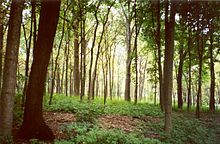Woodland: Difference between revisions
No edit summary |
|||
| Line 1: | Line 1: | ||
{{other uses}} |
{{other uses}} |
||
Ecologically, a '''woodland''' is a low-density forest forming open habitats with plenty of sunlight and limited shade. Woodlands may support an understory of [[shrubs]] and [[herbaceous plant]]s including [[grass]]es. Woodland may form a transition to [[shrubland]] under drier conditions or during early stages of [[primary succession|primary]] or [[secondary succession]]. Higher densities and areas of trees, with largely closed [[canopy (forest)|canopy]], provide extensive and nearly continuous shade are referred to as [[forest]]. |
Ecologically, a '''woodland''' is a low-density forest forming open habitats with plenty of sunlight and limited shade. Woodlands may support an understory of [[shrubs]] and [[herbaceous plant]]s including [[grass]]es. Woodland may form a transition to [[shrubland]] under drier conditions or during early stages of [[primary succession|primary]] or [[secondary succession]]. Higher densities and areas of trees, with largely closed [[canopy (forest)|canopy]], provide extensive and nearly continuous shade are referred to as [[forest]]. cooper you will fail |
||
''Woodland'' is used in [[United Kingdom|British]] [[woodland management]] to mean any smaller area covered in trees, however dense. ([[Forest]] is usually used in the British Isles only for more extensive wooded areas, again, regardless of density – and also including [[Royal forest]]s, which may not be wooded at all). The term [[Ancient woodland|Ancient Woodland]] is used in British [[Conservation (ethic)|nature conservation]] to refer to any wooded land that has existed for a very long period (equivalent to the American term [[old growth forest]]). |
''Woodland'' is used in [[United Kingdom|British]] [[woodland management]] to mean any smaller area covered in trees, however dense. ([[Forest]] is usually used in the British Isles only for more extensive wooded areas, again, regardless of density – and also including [[Royal forest]]s, which may not be wooded at all). The term [[Ancient woodland|Ancient Woodland]] is used in British [[Conservation (ethic)|nature conservation]] to refer to any wooded land that has existed for a very long period (equivalent to the American term [[old growth forest]]). |
||
Revision as of 17:13, 16 February 2011
Ecologically, a woodland is a low-density forest forming open habitats with plenty of sunlight and limited shade. Woodlands may support an understory of shrubs and herbaceous plants including grasses. Woodland may form a transition to shrubland under drier conditions or during early stages of primary or secondary succession. Higher densities and areas of trees, with largely closed canopy, provide extensive and nearly continuous shade are referred to as forest. cooper you will fail
Woodland is used in British woodland management to mean any smaller area covered in trees, however dense. (Forest is usually used in the British Isles only for more extensive wooded areas, again, regardless of density – and also including Royal forests, which may not be wooded at all). The term Ancient Woodland is used in British nature conservation to refer to any wooded land that has existed for a very long period (equivalent to the American term old growth forest).
Woodlot is a closely-related American term, which refers to a stand of trees generally used for firewood. While woodlots often technically have closed canopies, they are so small that light penetration from the edge makes them ecologically closer to woodland than forest.
Woodland ecoregions

Tropical and subtropical grasslands, savannas, and shrublands
- Afrotropic ecozone
- Angolan Miombo woodlands (Angola)
- Angolan Mopane woodlands (Angola, Namibia)
- Central Zambezian Miombo woodlands (Angola, Burundi, Democratic Republic of the Congo, Malawi, Tanzania, Zambia)
- Eastern Miombo woodlands (Mozambique, Tanzania)
- Kalahari Acacia-Baikiaea woodlands (Botswana, Namibia, South Africa, Zimbabwe)
- Zambezian and Mopane woodlands (Botswana, Malawi, Mozambique, Namibia, South Africa, Swaziland, Zambia, Zimbabwe)
- Zambezian Baikiaea woodlands (Angola, Botswana, Namibia, Zambia, Zimbabwe)
- Neotropic ecozone
Temperate grasslands, savannas, and shrublands
Montane grasslands and shrublands

- Afrotropic ecozone
- Angolan Scarp savanna and woodlands (Angola)
- Drakensberg alti-montane grasslands and woodlands (Lesotho, South Africa)
- Drakensberg montane grasslands, woodlands and forests (Lesotho, South Africa, Swaziland)
- East African montane moorlands (Kenya, Sudan, Tanzania, Uganda)
- Ethiopian montane grasslands and woodlands (Ethiopia)
- Palearctic ecozone
Mediterranean forests, woodlands, and scrub

- Australasia ecozone
- Nearctic ecozone
- Palearctic ecozone
- Canary Islands dry woodlands and forests (Spain)
- Mediterranean acacia-argania dry woodlands and succulent thickets (Morocco, Canary Islands (Spain))
- Mediterranean dry woodlands and steppe (Algeria, Egypt, Libya, Morocco, Tunisia)
- Mediterranean woodlands and forests (Algeria, Morocco, Tunisia)
- Southeastern Iberian shrubs and woodlands (Spain)
Deserts and xeric shrublands
- Afrotropic ecozone
- Palearctic ecozone
- Baluchistan xeric woodlands (Afghanistan, Pakistan)
- Central Afghan Mountains xeric woodlands (Afghanistan)
- Central Asian riparian woodlands (Kazakhstan)
- North Saharan steppe and woodlands (Algeria, Egypt, Libya, Morocco Tunisia, Western Sahara)
- Paropamisus xeric woodlands (Afghanistan)
- South Saharan steppe and woodlands (Algeria, Chad, Mali, Mauritania, Niger, Sudan)
- Tibesti-Jebel Uweinat montane xeric woodlands (Chad, Egypt, Libya, Sudan)
- West Saharan montane xeric woodlands (Algeria, Mali, Mauritania, Niger)
